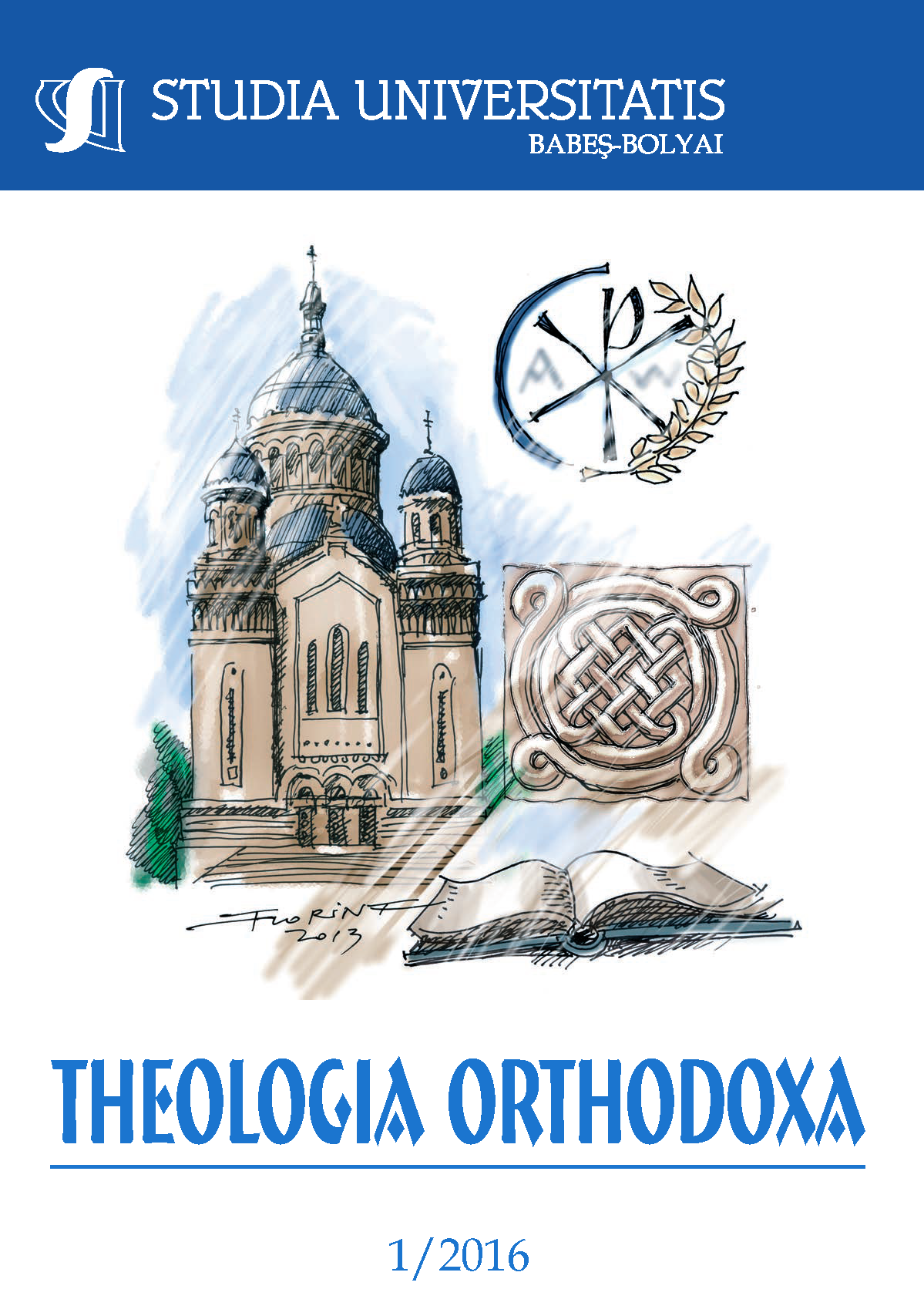LUKE’S ORIGINAL VISION ON TRANSFIGURATION STORY (LUKE 9: 27-36)
Keywords:
Kingdom of God, transfiguration, garments of skins, theophany, deificationAbstract
Our study is trying to identify the main instruction of the Transfiguration story, reflecting St. Luke’s point of view, using both patristic opinions and helpful modern commentaries. Apostle Luke depicts an original version of the Transfiguration Mountain: eight days passed after the promise of seeing the Kingdom of God; the transfiguration of Christ happens while He was praying; the noun ἔξοδον points out Lucanic original vision etc. The foremost kerygma that the disciples are about to learn is that of their own personal transfiguration, the only path of rediscovering the lost Image of a liturgical membership. The presence of the most towering prophets of the Old Testament here on the mountain, certify that before you enter into the Kingdom of God, you have to cross the Golgotha scene, a journey that all of us have to take in order to inherit eternal life. Trying to achieve a proper exegesis of the Sacred Texts is not easy to reach, that is why our work is far from being accomplished.
References
Bock, Darell L. “Luke 1:1-9:53.” In Baker Exegetical Commentary on the New Testament. Grand Rapids: Baker Books, 1994.
Bovon, Francois. “Luke: A Commentary on the Gospel of Luke 1:1-9:50”, vol. 1. In Hermeneia, Minneapolis: Fortress Press, 2002.
Carlston, Charles Edwin. “Transfiguration and Resurrection”, Journal of Biblical Literature 80 (1961): 233-240.
Crainic, Nichifor. Cursurile de mistică. Sibiu: Editura Deisis, 2010.
Ehrman Bart D. The New Testament. A Historical Introduction to the Early Christian Writings. Oxford: Oxford University Press, 2000.
Evans, Craig A. Luke, in New International Biblical Commentary. Peabody: Hendrickson Publishers, 1990.
Fitzmyer, Joseph A. “First Corinthians.” In The Anchor Yale Bible, vol. 32. New Haven: Yale University Press, 2008.
Friberg, Timothy, Barbara Friberg, and Neva F. Miller. Analytical Lexicon of the Greek New Testament, kindle edition, Baker Books, 2000.
Golitzin, Alexander. Mistagogia. Experienţa lui Dumnezeu în Ortodoxie. Sibiu: Editura Deisis, 1998.
Green, Joel B. “The Gospel of Luke.” In The New International Commentary on the New Testament. Grand Rapids: William B. Eerdmans Publishing Company, 1997.
Hillyer, C. N. “First Peter and the Feast of Tabernacles.” Tyndalle Bulletin 21 (1970): 39-70.
Iersel, B. M. F. van. “Fils de David et Fils de Dieu.” In La Venue du Messie. Messianisme et Eschatologie, 113-132. Löven, 1962.
Ioan Damaschinul, Saint. “Cuvânt la Schimbarea la Faţă/Chip a Domnului şi Mântuitorului nostru Iisus Hristos.” In Despre Lumina taborică, rugăciunea lui Iisus şi curăţia inimii. Edited by Ioan I. Ică jr, 77, Sibiu: Deisis, 2013.
Ioan Gură de Aur, Saint. “Omilii la Matei.” In Părinţi şi Scriitori Bisericeşti, vol. 23. Bucureşti: Editura Institutului Biblic și de Misiune al Bisericii Ortodoxe Române, 1994.
Kittel, Gerhard and Gerhard Friedrich. Theological Dictionary of the New Testament, vol. 7. Grand Rapids: William B. Eerdmans Publishing Company, 1964.
Ladd, George Eldon. The Presence of the Future. Grand Rapids: William B. Eerdmans Publishing Company, 1974.
Levine, Amy-Jilland Marc Zvi Brettler. The Jewish Annotated New Testament, Oxford: Oxford University Press, 2011.
Louw, Johannes E. and Eugene A. Nida. Greek-English Lexicon of the New Testament based on Semantic Domains. 2nd ed. New York: United Bible Societies, 1989.
Marshall, Howard. “The Gospel of Luke.” In The New International Greek Testament Commentary, edited by Howard Marshall and W. Ward Gasque, Grand Rapids: William B. Eerdmans Publishing Company, 1986.
Maxim Mărturisitorul, Saint. Ambigua. In Părinţi şi Scriitori Bisericeşti, vol. 80, edited by Dumitru Stăniloae, Bucureşti: Editura Institutului Biblic și de Misiune al Bisericii Ortodoxe Române, 1983.
Nellas, Panayotis. Omul – animal îndumnezeit. Perspective pentru o antropologie ortodoxă. Sibiu: Editura Deisis, 2009.
Nolland, John. “Luke 9:21-18:34.” In Word Biblical Commentary. Dallas: Word Books, 1993.
Spence, H.D.M. and Joseph S. Exell. “St. Mark.” In The Pulpit Commentary, vol. 36. London: Funk&Wagnalls Company, 1913.
Stăniloae, Dumitru. Iisus Hristos lumina lumii şi îndumnezeitorul omului. Bucureşti: Editura Anastasia, 1993.
Stein, Robert. Luke, in New American Commentary, vol. 24. Nashville: Broadman Press, 1992.
Varga, Cătălin, Few New Testament Studies: An Orthodox Apology. Saarbrücken: LAP LAMBERT Academic Publishing, 2016.
Vine, W. E., Merrill F. Unger, and William White. Vine’s Complete Expository Dictionary of Old and New Testament Words, vol. 1. Nashville: Thomas Nelson Publishers, 1996.
Wanamaker Charles A. The Epistles to the Thessalonians. A Commentary on the Greek Text. Grand Rapids: William B. Eerdmans Publishing Company, 1990.
Yen Do, Maria. The Lucan Journey: A Study of Luke 9:28-36 and Acts 1:6-11 as an Architectural Pair. Bern: International Academic Publishers, 2010.
Zhekov, Yordan Kalevand and Corneliu Constantineanu, “The Presence of the Future: The Eschatological Framework of the New Testament.” Plērōma 2 (2010): 49-68.
Downloads
Published
How to Cite
Issue
Section
License
Copyright (c) 2016 Studia Universitatis Babeș-Bolyai Theologia Orthodoxa

This work is licensed under a Creative Commons Attribution-NonCommercial-NoDerivatives 4.0 International License.





 ISSN (print): 1224-0869, ISSN (online): 2065-9474, ISSN-L: 2065-9474
ISSN (print): 1224-0869, ISSN (online): 2065-9474, ISSN-L: 2065-9474